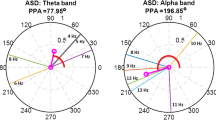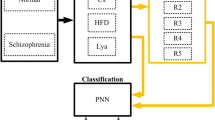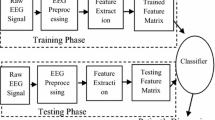Abstract
Being one of the most prominent neurological development disorder, autism spectrum disorder (ASD) has arisen as global issue. It emerges over the first few years of life and neurologist diagnose ASD by considering various factors. A biomarker, such as an electroencephalogram (EEG), may be employed to aid the diagnosis process as it can easily track abnormal changes in the patient’s brain. Therefore, this paper intends to propose an ensemble empirical mode decomposition based novel approach with multiscale fluctuation dispersion entropy for automated diagnosis of ASD patients using multichannel EEG signals. The various boosting classifiers which are empowered with Bayesian optimization based parameter estimation technique are considered to evaluate performance of proposed approach. Finally, the overall analysis of results exhibits that light gradient boosting machine (LGBM) produces maximum accuracy, specificity, and sensitivity of 99.59%, 99.37%, and 99.18% respectively with 0.9998 value of area under curve and 0.9919 value of Kappa statistic with optimally small computational time and minimum error measures.






Similar content being viewed by others
Data availability
The data that support the findings of this study are available from third party at King Abdulaziz University (KAU), Saudi Arabia, Jeddah. The data are however available upon reasonable request from the developers of KAU.
References
Lord C, Charman T, Havdahl A, Carbone P, Anagnostou E, Boyd B, Carr T, De Vries PJ, Dissanayake C, Divan G, Freitag CM (2022) The Lancet Commission on the future of care and clinical research in autism. Lancet 399(10321):271–334
Lord C, Brugha TS, Charman T, Cusack J, Dumas G, Frazier T, Jones EJ, Jones RM, Pickles A, State MW, Taylor JL, Veenstra-VanderWeele J (2020) Autism spectrum disorder. Nat Rev Dis Primers 6(1):1–23
Jullien S (2021) Screening for autistic spectrum disorder in early childhood. BMC Paediatr 21(1):1–9
Patra S, Kar SK (2021) Autism spectrum disorder in India: a scoping review. Int Rev Psychiatry 33(1–2):81–112
Hyman SL, Levy SE, Myers SM, Kuo DZ, Apkon S, Davidson LF, Ellerbeck KA, Foster JE, Noritz GH, Leppert MO, Saunders BS (2020) Identification, evaluation, and management of children with autism spectrum disorder. Pediatrics 145(1):e20193447. https://doi.org/10.1542/peds.2019-3447
Bosl WJ, Tager-Flusberg H, Nelson CA (2018) EEG analytics for early detection of autism spectrum disorder: a data-driven approach. Sci Rep 8(1):1–20
Tawhid MN, Siuly S, Wang H, Whittaker F, Wang K, Zhang Y (2021) A spectrogram image based intelligent technique for automatic detection of autism spectrum disorder from EEG. PLoS ONE 16(6):e0253094
Alhaddad MJ, Kamel MI, Malibary HM, Alsaggaf EA, Thabit K, Dahlwi F, Hadi AA (2012) Diagnosis autism by fisher linear discriminant analysis FLDA via EEG. Int J Bio-Sci Bio-Technol 4(2):45–54
Alsaggaf EA, Kamel MI (2014) Using EEGs to diagnose autism disorder by classification algorithm. Life Sci J 11(6):305–308
Abdolzadegan D, Moattar MH, Ghoshuni M (2020) A robust method for early diagnosis of autism spectrum disorder from EEG signals based on feature selection and DBSCAN method. Biocybern Biomed Eng 40(1):482–493
Kang J, Zhou T, Han J, Li X (2018) EEG-based multi-feature fusion assessment for autism. J Clin Neurosci 56:101–107
Ibrahim S, Djemal R, Alsuwailem A (2018) Electroencephalography (EEG) signal processing for epilepsy and autism spectrum disorder diagnosis. Biocybern Biomed Eng 38(1):16–26
Alturki FA, AlSharabi K, Abdurraqeeb AM, Aljalal M (2020) EEG signal analysis for diagnosing neurological disorders using discrete wavelet transform and intelligent techniques. Sensors 20(9):2505
Wadhera T, Kakkar D (2021) Social cognition and functional brain network in autism spectrum disorder: insights from EEG graph-theoretic measures. Biomed Signal Process Control 67:102556
Mohi-ud-Din Q, Jayanthy AK (2021) Detection of Autism Spectrum Disorder from EEG signals using pre-trained deep convolution neural networks. In: 2021 Seventh International conference on Bio Signals, Images, and Instrumentation (ICBSII), Chennai, India, 25–27 March 2021 (pp. 1–5). IEEE
Thirumal S, Thangakumar J (2022) Investigation of hybrid feature selection techniques for autism classification using EEG signals. Int J Adv Comput Sci Appl 13(4). https://doi.org/10.14569/IJACSA.2022.0130475
Grossi E, Olivieri C, Buscema M (2017) Diagnosis of autism through EEG processed by advanced computational algorithms: A pilot study. Comput Methods Programs Biomed 142:73–79
Oh SL, Jahmunah V, Arunkumar N, Abdulhay EW, Gururajan R, Adib N, Ciaccio EJ, Cheong KH, Acharya UR (2021) A novel automated autism spectrum disorder detection system. Compl Intell Syst 7(5):2399–2413
Tawhid MN, Siuly S, Wang H (2020) Diagnosis of autism spectrum disorder from EEG using a time–frequency spectrogram image-based approach. Electron Lett 56(25):1372–1375
Chawla P, Rana SB, Kaur H, Singh K (2022) Computer-aided diagnosis of autism spectrum disorder from EEG signals using deep learning with FAWT and multiscale permutation entropy features. Proc Inst Mech Eng H 237(2):282–294. https://doi.org/10.1177/09544119221141751
Ari B, Sobahi N, Alçin ÖF, Sengur A, Acharya UR (2022) Accurate detection of autism using Douglas-Peucker algorithm, sparse coding based feature mapping and convolutional neural network techniques with EEG signals. Comput Biol Med 143:105311
Wadhera T, Bedi J, Sharma S (2023) Autism spectrum disorder prediction using bidirectional stacked gated recurrent unit with time-distributor wrapper: an EEG study. Neural Comput Appl 35(13):9803–9818
Abdulhay E, Alafeef M, Alzghoul L, Al Momani M, Al Abdi R, Arunkumar N, Munoz R, de Albuquerque VH (2020) Computer-aided autism diagnosis via second-order difference plot area applied to EEG empirical mode decomposition. Neural Comput Appl 32:10947–10956
Sharma S, Tiwari SK (2022) A novel feature extraction method based on weighted multi-scale fluctuation based dispersion entropy and its application to the condition monitoring of rotary machines. Mech Syst Signal Process 171:108909
Wu Z, Huang NE (2009) Ensemble empirical mode decomposition: a noise-assisted data analysis method. Adv Adapt Data Anal 1(01):1–41
Chawla P, Rana SB, Kaur H, Singh K (2022) Classification of epileptic seizures using EEMD with multi-entropy features integrating different tree classifiers. In computational vision and bio-inspired computing: proceedings of ICCVBIC 2022 (pp 139–157). Springer Nature Singapore, Singapore
Chawla P, Rana SB, Kaur H, Singh K, Yuvaraj R, Murugappan M (2023) A decision support system for automated diagnosis of Parkinson’s disease from EEG using FAWT and entropy features. Biomed Signal Process Control 79:104116
Singh G, Kaur M, Singh B (2021) Detection of epileptic seizure EEG signal using multiscale entropies and complete ensemble empirical mode decomposition. Wireless Pers Commun 116:845–864
Costa M, Goldberger AL, Peng CK (2002) Multiscale entropy analysis of complex physiologic time series. Phys Rev Lett 89(6):068102
Humeau-Heurtier A (2020) Multiscale entropy approaches and their applications. Entropy 22(6):644
Azami H, Arnold SE, Sanei S, Chang Z, Sapiro G, Escudero J, Gupta AS (2019) Multiscale fluctuation-based dispersion entropy and its applications to neurological diseases. IEEE Access 7:68718–68733
Yousefi Rizi F (2019) A review of notable studies on using Empirical Mode Decomposition for biomedical signal and image processing. Signal Process Renew Energy 3(4):89–113
Tang L, Lv H, Yu L (2017) An EEMD-based multi-scale fuzzy entropy approach for complexity analysis in clean energy markets. Appl Soft Comput 56:124–133
Kamel MI, Alhaddad MJ, Malibary HM, Thabit K, Dahlwi F, Alsaggaf EA, Hadi AA (2012) EEG based autism diagnosis using regularized Fisher Linear Discriminant Analysis. Int J Image Graph Sig Process 4(3):35
Singh K, Malhotra J (2022) Smart neurocare approach for detection of epileptic seizures using deep learning based temporal analysis of EEG patterns. Multimed Tools Appl 81(20):29555–29586
Karabiber Cura O, Kocaaslan Atli S, Türe HS, Akan A (2020) Epileptic seizure classifications using empirical mode decomposition and its derivative. Biomed Eng Online 19:1–22
Minhas AS, Singh G, Singh J, Kankar PK, Singh S (2020) A novel method to classify bearing faults by integrating standard deviation to refined composite multi-scale fuzzy entropy. Measurement 154:107441
Humeau-Heurtier A (2020) Entropy analysis in health informatics. In Book: Sig Process Tech Computat Health Inform pp 123–143. https://doi.org/10.1007/978-3-030-54932-9_5
Krishnan S, Athavale Y (2018) Trends in biomedical signal feature extraction. Biomed Signal Process Control 43:41–63
Azami H, Escudero J (2018) Amplitude-and fluctuation-based dispersion entropy. Entropy 20(3):210
Anowar F, Sadaoui S, Selim B (2021) Conceptual and empirical comparison of dimensionality reduction algorithms (pca, kpca, lda, mds, svd, lle, isomap, le, ica, t-sne). Comput Sci Rev 40:100378
Xiong Q, Xiong H, Kong Q, Ni X, Li Y, Yuan C (2022) Machine learning-driven seismic failure mode identification of reinforced concrete shear walls based on PCA feature extraction. Structures 44:1429–1442
Rahman S, Irfan M, Raza M, Moyeezullah Ghori K, Yaqoob S, Awais M (2020) Performance analysis of boosting classifiers in recognizing activities of daily living. Int J Environ Res Public Health 17(3):1082
Albaqami H, Hassan GM, Subasi A, Datta A (2021) Automatic detection of abnormal EEG signals using wavelet feature extraction and gradient boosting decision tree. Biomed Signal Process Control 70:102957
Tamim Kashifi M, Ahmad I (2022) Efficient histogram-based gradient boosting approach for accident severity prediction with multisource data. Transp Res Rec 2676(6):236–258
Elgeldawi E, Sayed A, Galal AR, Zaki AM (2021) Hyperparameter tuning for machine learning algorithms used for arabic sentiment analysis. Inform Multidiscip Digit Publ Inst 8(4):79
Frazier PI (2018) A tutorial on Bayesian optimization. arXiv preprint arXiv:1807.02811
Wu J, Chen XY, Zhang H, Xiong LD, Lei H, Deng SH (2019) Hyperparameter optimization for machine learning models based on Bayesian optimization. J Electron Sci Technol 17(1):26–40
Villavicencio CN, Macrohon JJ, Inbaraj XA, Jeng JH, Hsieh JG (2021) Covid-19 prediction applying supervised machine learning algorithms with comparative analysis using weka. Algorithms 14(7):201
Khan B, Naseem R, Shah MA, Wakil K, Khan A, Uddin MI, Mahmoud M (2021) Software defect prediction for healthcare big data: an empirical evaluation of machine learning techniques. J Healthc Eng 8899263. https://doi.org/10.1155/2021/8899263
Chung S, Son JW (2020) Visual perception in autism spectrum disorder: A review of neuroimaging studies. J Korean Acad Child Adolesc Psychiatry 31(3):105
Shoieb D, Youssef S (2021) Neurological disorder detection of brain abnormal activities using a new enhanced computer-aided model. J Phys Conf Ser 2128(1):012017 (IOP Publishing)
Melinda M, Juwono FH, Enriko IK, Oktiana M, Mulyani S, Saddami K (2023) Application of continuous wavelet transform and support vector machine for autism spectrum disorder electroencephalography signal classification. Radioelectron Comput Syst 29(3):73–90
Acknowledgements
The authors would like to thank Prof. Mohammed Jaffer Alhaddad (KAU, Kingdom of Saudi Arabia, Jeddah) for sharing their raw EEG dataset used in this study.
Author information
Authors and Affiliations
Corresponding author
Ethics declarations
Ethics approval
This article does not contain any studies with animals performed by the authors.
Conflict of interests
The author(s) declared no potential conflicts of interest with respect to the research, authorship, and/or publication of this article.
Additional information
Publisher's Note
Springer Nature remains neutral with regard to jurisdictional claims in published maps and institutional affiliations.
Rights and permissions
Springer Nature or its licensor (e.g. a society or other partner) holds exclusive rights to this article under a publishing agreement with the author(s) or other rightsholder(s); author self-archiving of the accepted manuscript version of this article is solely governed by the terms of such publishing agreement and applicable law.
About this article
Cite this article
Chawla, P., Rana, S.B., Kaur, H. et al. Diagnosis of autism spectrum disorder using EEMD and multiscale fluctuation based dispersion entropy with Bayesian optimized light GBM. Multimed Tools Appl (2024). https://doi.org/10.1007/s11042-023-18059-x
Received:
Revised:
Accepted:
Published:
DOI: https://doi.org/10.1007/s11042-023-18059-x




